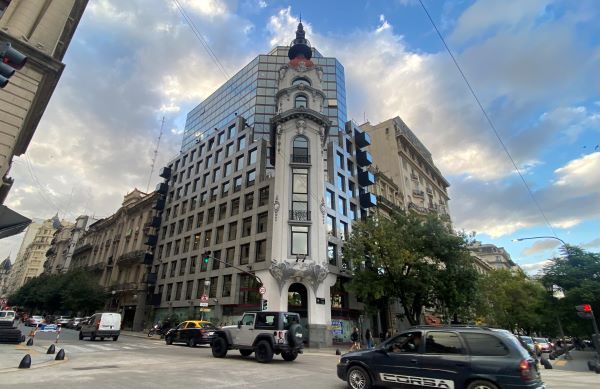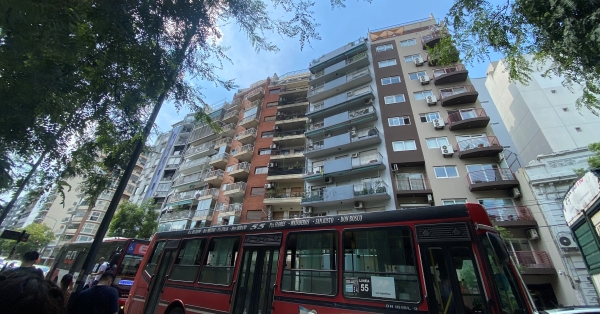Discovering the Porteño Way While Studying Abroad in Buenos Aires
Thinking about studying abroad in Buenos Aires? Here is a quick guide to some cultural essentials I’ve learned during my amazing time here so far to give you a better idea of what things are like.
The Basics
One of the first cultural practices I easily adjusted to during my first week in Buenos Aires was the schedule. Buenos Aires’ rhythm is fast-paced and busy—you’ll never find an empty street—and its 3 million inhabitants, referred to as Porteños, are very active from very early in the day to very late. Unlike Spain, whose schedule also goes quite late, there is no siesta here in the city, though you might come across it in the province and other areas of Argentina. Instead, the mid-to-late afternoon involves merienda, the third meal of the day (it can also be thought of as a big snack), often taken with a coffee at one of the city’s thousands of cafés.

Buenos Aires combines traditional/historic and modern elements in its culture, as well as its buildings.
Moving ahead then, dinner starts at any point between 9:00 and 11:00 PM and is typically followed by sobremesa, a family’s time to share and converse about anything and everything. As I’ll touch on later, weekends are characterized by even later days, but throughout the week, Buenos Aires lives up to the phrase I’ve heard from countless Porteños—the city that never sleeps.
The second important basic is public transportation, which is fashioned to meet the demand of the city’s constant movement. The colectivo (bus) system is the most far-reaching and abundant, with over a hundred lines connecting all the corners of the city you could ever need to get to. One important note is that when traveling by colectivo, you must know the stop you are getting off at before you get on; as you get on, you tell the driver where you’re going and they will charge you accordingly (there isn’t a fixed cost). Don’t let this scare you though, commuting by colectivos is one of the best ways to see and feel part of the action of Buenos Aires, and it’s genuinely become one of my favorite parts of each day.

A couple of colectivos drive by the street.
Beyond colectivos, there are the subte and the mitre. The former is the underground subway, quite similar to most subway systems around the world, and very useful for getting around mostly in the center parts of the city. Finally, the mitre is the best for traveling to neighborhoods or towns slightly further outside the city center, for example, Tigre.
There are two smaller elements of the city I want to mention briefly. For all dog lovers, prepare to encounter countless (adorable) dogs each day! There is an unmistakable love of dogs in Buenos Aires, as seen by the pet stores found everywhere and the dog walkers walking anywhere from 5 to 10+ dogs. Then, if you have any dietary needs or preferences, Buenos Aires is very accommodating and also has a strong emphasis on health—dieteticas (health food stores) are everywhere and offer special products for any specific food needs.

So many dogs in Buenos Aires!
Living Like a Porteño
Now we can advance to some of the deeper parts of Porteño culture. The first is one that actually extends to a much greater area than Buenos Aires, including large swaths of Argentina, Uruguay, Paraguay, and Brazil, and is the old tradition of drinking mate. Mate is an infused drink made from the yerba mate plant and is an essential part of every Porteño’s day, though not limited to a specific moment—I have been told that mate is for all hours. However, it’s also clear that it is more than just a beverage: it is a social tradition.
During any given hangout, mate will be present, and the cup will be passed from person to person, an experience of sharing a drink while in conversation. Mate also extends across class and age differences. I've seen all kinds of people with their mates and thermoses in parks and plazas—even middle and high school students carrying them around as they walk around after getting out of school for the day. In summary, it’s something extremely common, visible, and is quite likely to rub off on you within a few weeks here!
Next, we have the nightlife, perhaps one of the greatest in the world. Personally, the nightlife of Buenos Aires has brought forth some of the most distinct and memorable experiences of my time here. Friday and Saturday are the big nights, but you can also always find concerts, shows, and other activities on Thursdays and Sundays.

Lucille, a really cool live music venue, I ended up in one night.
The Palermo neighborhood holds a great deal of the city’s nightlife, centered around the famous Plaza Serrano, where you can find establishments with all kinds of themes, musical genres, and interests, from reggaeton to jazz to indie rock and more. Whatever you choose in Buenos Aires on the weekend, you will have so much fun.
Another cultural element that is deeply rooted in the city’s history is café culture. If you take the CEA CAPA class Food & Culture in Argentina, you’ll get to learn more about this, but at the core, going to a café for a Porteño is like a quick but fulfilling break from the sprint that is the city. Some cafés, known as bares notables, go back to the 20th century and allow you to feel the spirit of conversation, intellectual life, and reflection. The experience of going to a café can be social—you’ll constantly see pairs and groups deep in dialogue around a table—but also individual—for example, to read, catch up on any quick tasks, or get some work done.

We visited La Ideal, a historic café, with our CEA CAPA Food & Culture class.
Today, you can also find cafés of all sorts, ranging from the historic ones mentioned to modern cafés de especialidad, which emphasize specialty coffee drinks, and each has a different overall vibe. Ultimately, cafés represent a short breath away from the bustle of the city, a moment to center yourself in the middle of the bustle that continues around you.
Altogether, Buenos Aires is a rich and dynamic place and is sure to bring any study abroad student an array of wonderful learning and cultural experiences!











